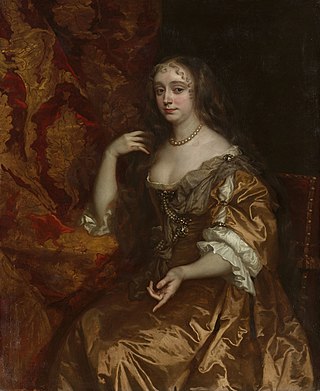Princess Anne (born 1950) is the daughter of Queen Elizabeth II and Prince Philip, Duke of Edinburgh.
Contents
Princess Anne may also refer to:
Princess Anne (born 1950) is the daughter of Queen Elizabeth II and Prince Philip, Duke of Edinburgh.
Princess Anne may also refer to:

Sophia was Electress of Hanover from 19 December 1692 until 23 January 1698 as the consort of Prince Elector Ernest Augustus. She was later the heiress presumptive to the thrones of England and Scotland and Ireland under the Act of Settlement 1701, as a granddaughter of King James VI and I. Sophia died less than two months before she would have become Queen of Great Britain and Ireland. Consequently, her son George I succeeded her first cousin once removed, Queen Anne, to the British throne, and the succession to the throne has since been defined as, and composed entirely of, Sophia's legitimate and Protestant descendants.
Queen Anne can refer to:

Mary of Modena was Queen of England, Scotland and Ireland as the second wife of James II and VII. A devout Catholic, Mary married the widower James, who was then the younger brother and heir presumptive of Charles II. She was devoted to James and their children, two of whom survived to adulthood: the Jacobite claimant to the thrones, James Francis Edward, and Louisa Maria Teresa.

Anne Hyde was the first wife of James, Duke of York, who later became King James II and VII.

Anne, alternatively spelled Ann, is a form of the Latin female given name Anna. This in turn is a representation of the Hebrew Hannah, which means 'favour' or 'grace'. Related names include Annie.

The use of the title of Princess of the United Kingdom of Great Britain and Northern Ireland is entirely at the will of the sovereign, and is now expressed in letters patent. Individuals holding the title of princess will usually also be granted the style of Her Royal Highness (HRH). The current letters patent were issued in 1917 during the World War I, with one extension in 2012.
Princess Louise may refer to:
Princess Elizabeth or Princess Elisabeth may refer to:
Princess Mary may refer to:

Duchess Marie Elisabeth of Saxony was a duchess consort of Holstein-Gottorp as the spouse of Duke Frederick III of Holstein-Gottorp. As a widow, she became known as a patron of culture.
Anna of Saxony (1544–1577), was the daughter of Maurice, Elector of Saxony and wife of William the Silent.
Duchess Anne may refer to:

Christine Marie of France was Duchess of Savoy from 26 July 1630 to 7 October 1637 as the consort of Duke Victor Amadeus I. She was the daughter of Henry IV of France and sister of Louis XIII. Following her husband's death in 1637, she acted as regent of Savoy between 1637 and 1648.
Archduchess Maria may refer to a number of historical noblewomen of Austria:
Marie d'Orléans may refer to:
Princess Frederica or Princess Frederika may refer to:
Anne Stuart may refer to:

Antoinette Amalie of Brunswick-Wolfenbüttel was a Duchess of Brunswick-Wolfenbüttel by marriage to Ferdinand Albert II of Brunswick-Wolfenbüttel. She was the mother of the Queen of Prussia, the Duchess of Saxe-Coburg-Saalfeld and the Queen of Denmark and Norway.
Since William the Conqueror claimed the English throne, succession has been determined by bequest, battle, primogeniture, and parliament.